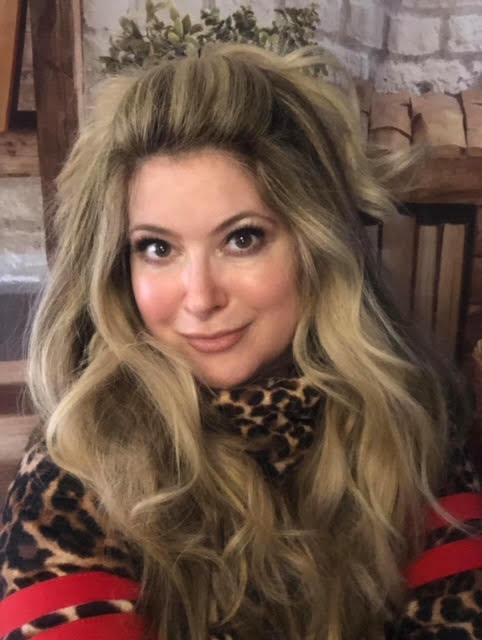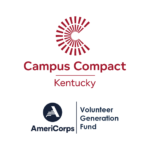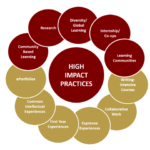KyCC Faculty Spotlight: Heather Logsdon
Hands-on, project-based activities increase
understanding, knowledge, creative thinking, and
mental well-being that are essential to living a good life.  Heather Logsdon, MFA
Heather Logsdon, MFA
Associate Art Professor
Kentucky Wesleyan College
Heather Logsdon reflected on her recent experiences leading a service-learning project entitled: The Monet Project: Repurpose, Reuse, Recycle (Revitalization of the Ralph for Visual Aesthetics on Campus and in the Community). Learn more about the project, including background information and student photos.
When asked about what service-learning means to her, Logsdon discussed her role as a professor, providing an opportunity for her students to develop civic engagement by working with the community on a common goal for improving and educating.
“By identifying a community need (Recycling), students are able to directly help the community by Repurposing unwanted items/trash for Reuse of those items in creating an aesthetically pleasing artwork,” she said. “Through the service of recycling, the students help the neighborhood change their perspective in what we as a community can do to reform the trash to something purposeful, and the neighborhood helps students to use their artistic skills to beautiful the community area of the Ralph courtyard.”
This form of experiential education allows her students to take action and support the community’s sense of well-being through beautification efforts. It will also give students more aesthetic awareness and help develop their sense of purpose.
This service-learning project has affected Logsdon’s career tremendously as she begins to incorporate this type of experiential learning into her curriculum across her classes.
“Identifying a community need brought an awareness that I could teach my students a world view perspective while guiding them through the recycling process to benefit both the student and the community,” she explained. “My classes will have a service-learning component because hands-on, project-based activities increase understanding, knowledge, creative thinking, and mental well-being that are essential to living a good life.”
Logsdon incorporated civic engagement on a smaller scale before the “Monet Project” with ART411 and ART412, identifying a need of branding new startup businesses through the Owensboro Chamber of Commerce. The startup business that could not afford the essential design work would offer specs to my students to gain real-world experience by offering student-designed branding materials for professional use.
The trade-off came three-fold:
- Logsdon pushed learning outside of the classroom to fulfill both a student and community need, improving her teaching pedagogy.
- Students gained design skills with real-world projects for their portfolio experience.
- The business gained branding it may not be able to afford to service the community.
When asked about a personal service-learning experience, Logsdon described her collaboration with a local agency. The Owensboro Oasis Shelter requested her students to paint chairs as an assignment project for ART235: Painting I. Then, the community donated the chairs to auction off in the shelter’s Chair-a-Tea event.
“My students were able to paint these wonderful designs and paintings onto the chairs to use their talents to help the shelter raise money through an auction that would benefit domestically abused women and children,” she explained. “This experience was dear to my heart because I was able to pay forward what the shelter did for me and my children, while seeing the impact it had on my students having a sense of purpose with their skills, and finally helping the shelter to raise money for a great service they provide to Owensboro’s families to heal into productive citizens.”
Logsdon also reflected on a powerful experience with a particular student in her Chair-a-Tea painting class. While designing the chair in a thumbnail, she saw that a student was looking a bit uncomfortable.
“I went over to ask her if everything was alright, and she responded that she HAD to get her design right,” she explained. “I told her to just have fun with it, and she sat silent. I placed my hand on her shoulder and asked if she wanted to take a walk outside and discuss her design, to which she replied yes. She was silent as we walked, and I knew something was bothering her – I just walked with her. After a bit, she said her design had to be perfect since it was for a great cause.”
Logsdon assured her that anything she created would be perfect. The student told her this was not just a grade for her, to which Logsdon replied, “It isn’t just an assignment for me. Oasis helped me once, and you (my student) are a part of me paying that help forward.”
Then the student opened up with her, sharing she was trying to take care of her younger (toddler) sister because both her parents were abusing drugs and alcohol. At times, they would be violent.
“I got her in touch with our school counselor,” Logsdon said. “My student bravely took the necessary steps to move out, gain custody of her sister, and get them both away from her parents. Then, Oasis reached out and offered free tickets to the auction for every student that painted a chair.”
This student attended the event with her younger sister, showing off the chair she painted. “The student returned that Monday with such a smile on her face that words can not do justice,” she described. “She proudly bragged how much her chair went for in the auction and showed me photos.”
Logsdon wondered if she did not add this service-learning project to the class, what would have happened to this student? What about her sister?
“She often messages me and is working at a museum with her own family growing,” Logsdon shared. “Her sister is doing well and looking at high school.”
Based on Bloom’s Taxonomy, creation is at the top of the hierarchical list for learning. By combining creation with service-learning, Logsdon feels her students have a profound learning experience rooted in applying what they learn to make something new through the wisdom of exploring the question of why and building a solution to impact not only “self” but “others.”


